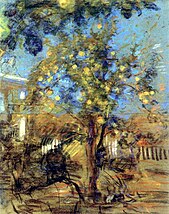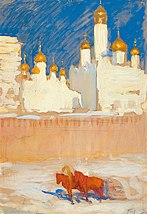| Revision as of 16:10, 11 February 2018 editBurne-Jones (talk | contribs)Extended confirmed users4,414 edits →Biography: added information about acquisitionTags: Mobile edit Mobile web edit← Previous edit | Revision as of 00:49, 12 June 2018 edit undoEwulp (talk | contribs)Autopatrolled, Extended confirmed users, Rollbackers40,321 edits del one not by Pasternak; ceNext edit → | ||
| Line 13: | Line 13: | ||
| ]). Purchased 1900.]]] | ]). Purchased 1900.]]] | ||
| The start of his career was very successful. His first exhibited painting was bought by ], the most important art sponsor in Russia of the time. He soon became a popular painter, a member of the so-called ] circle, that included ], ], ], ]. In 1889 he married the pianist Rosa Isidorovna Kaufman, the daughter of Isidor Kaufman, a well-to-do Jewish industrialist. The newlyweds settled in Moscow and in (1890) the first of the couple's four children was born — the famous author and poet ]. | The start of his career was very successful. His first exhibited painting was bought by ], the most important art sponsor in Russia of the time. He soon became a popular painter, a member of the so-called ] circle, that included ], ], ], and ]. In 1889 he married the pianist Rosa Isidorovna Kaufman, the daughter of Isidor Kaufman, a well-to-do Jewish industrialist. The newlyweds settled in Moscow and in (1890) the first of the couple's four children was born — the famous author and poet ]. | ||
| Leonid Pasternak was one of the first Russian painters who labeled himself an ]. In Russia in the 1880s and 1890s such a proclamation was novel enough to draw attention to an artist. Leonid also was a member of the ] and ] movements. He was a friend of ], for months lived in ], and painted many portraits of the great writer, also illustrating his novels '']'' and '']''. | Leonid Pasternak was one of the first Russian painters who labeled himself an ]. In Russia in the 1880s and 1890s such a proclamation was novel enough to draw attention to an artist. Leonid also was a member of the ] and ] movements. He was a friend of ], for months lived in ], and painted many portraits of the great writer, also illustrating his novels '']'' and '']''. | ||
| Line 30: | Line 30: | ||
| == Works == | == Works == | ||
| <gallery mode=packed heights= |
<gallery mode=packed heights=143px caption="Portraits"> | ||
| Image:Pasternak fedorov.jpg|] | Image:Pasternak fedorov.jpg|'']'', pastel on paper | ||
| File:Dr Osip Kaufmann by L.Pasternak (1897).jpg | File:Dr Osip Kaufmann by L.Pasternak (1897).jpg|''Dr. Ossip Kaufmann'' | ||
| Image:Pasternak ptlevinoj.jpg|E. Levina 1916 | Image:Pasternak ptlevinoj.jpg|''E. Levina'', 1916, tempera and pastel on paper mounted on canvas | ||
| File:BORIS BESIDE THE BALTIC AT MEREKULE, 1910 by L.Pasternak.jpg| |
File:BORIS BESIDE THE BALTIC AT MEREKULE, 1910 by L.Pasternak.jpg| ''] Beside the Sea'', 1910, oil on canvas | ||
| Image:Pasternakportretvsuka.jpg|Conductor |
Image:Pasternakportretvsuka.jpg|''Conductor ]'', 1898 | ||
| File:Kluchevsky by L. Pasternak (1909).jpg| |
File:Kluchevsky by L. Pasternak (1909).jpg|'']'' | ||
| Image:Pasternak gershenzon.jpg|], 1917 | Image:Pasternak gershenzon.jpg|'']'', 1917, oil on canvas | ||
| File:Rilke in Moscow by L.Pasternak (1928).jpg| |
File:Rilke in Moscow by L.Pasternak (1928).jpg|'']'' | ||
| Image:Pasternak leo tolstoy.jpg|] | Image:Pasternak leo tolstoy.jpg|'']'' | ||
| File:Profile portrait of Leo Tolstoy by L. Pasternak.jpg| |
File:Profile portrait of Leo Tolstoy by L. Pasternak.jpg|''Leo Tolstoy'', 1908 | ||
| Image:Pasternak podlampoj.jpg|Under a Lamp |
Image:Pasternak podlampoj.jpg|''Under a Lamp (Leo Tolstoy in his Family Circle)'', 1902, pastel on paper | ||
| File: |
File:Shaul Tchernichovsky by L.Pasternak.jpg|'']'', 1928, oil on canvas | ||
| File:Shaul Tchernichovsky by L.Pasternak.jpg|] | |||
| </gallery> | </gallery> | ||
| <gallery mode=packed heights= |
<gallery mode=packed heights=143px caption="Landscapes and other"> | ||
| Image:Pasternaknaplyage.jpg|Island ], 1906 | Image:Pasternaknaplyage.jpg|Island ], 1906, pastel on paper | ||
| Image:Pasternakvorobyovygory.jpg|The Golden Autumn. (Vorobyovy Mountains in Moscow) |
Image:Pasternakvorobyovygory.jpg|''The Golden Autumn. (Vorobyovy Mountains in Moscow)'' | ||
| Image:Pasternakuoknaosen.jpg|At the Window. Autumn |
Image:Pasternakuoknaosen.jpg|''At the Window. Autumn'', 1913, pastel on paper | ||
| Image:Pasternaksosnyimore.jpg|Pine-trees and the Sea |
Image:Pasternaksosnyimore.jpg|''Pine-trees and the Sea'', 1910, ] on paper | ||
| Image:Pasternak Apples.jpg|Collecting Apples, 1918 | Image:Pasternak Apples.jpg|''Collecting Apples'', 1918 | ||
| File:Ростова пастернак.jpeg|]'s |
File:Ростова пастернак.jpeg|'']'s First Ball'', 1893, watercolor | ||
| File:Leonid Pasternak - The Moscow Kremlin in the March Sun, 1917.jpg|The Moscow Kremlin in the March Sun, 1917 | File:Leonid Pasternak - The Moscow Kremlin in the March Sun, 1917.jpg|''The Moscow Kremlin in the March Sun'', 1917 | ||
| </gallery> | </gallery> | ||
Revision as of 00:49, 12 June 2018
For other people named Pasternak, see Pasternak.
Leonid Osipovich Pasternak (born Yitzhok-Leib, or Isaak Iosifovich, Pasternak; Template:Lang-ru, 3 April 1862 (N.S.) – 31 May 1945) was a Russian post-impressionist painter. He was the father of the poet and novelist Boris Pasternak.
Biography

Pasternak was born in Odessa to an Orthodox Jewish family on 4 April 1862. The family claimed to be distantly descended, in one line, from Isaac Abrabanel, the famous 15th-century Jewish philosopher and treasurer of Portugal, although no independent evidence of this exists. Leonid's father made an income by renting out a guest house. The courtyard of the guest house, with its adjoining coach-house, first awakened Leonid's artistic imagination. He was the youngest of the six children in the family.
He started to draw very early, but his family tried to discourage him, as they feared that his drawing would interfere with his studies. His first sponsor was the local street cleaner who began buying Pasternak's art when Leonid was seven years old. During 1879–81 Leonid Pasternak was a graduate of the Grekov Odessa Art school.
From 1881 to 1885, Leonid studied at Moscow University, first in the Department of Medicine, then at the Department of Law. Eventually he decided to devote his life to art and entered the Royal Academy of Fine Arts in Munich from which he graduated in 1887. He returned to Russia, served the compulsory two years in the Imperial Russian Army (artillery regiment) and in 1889 started a career as a full-time painter.


The start of his career was very successful. His first exhibited painting was bought by Pavel Tretyakov, the most important art sponsor in Russia of the time. He soon became a popular painter, a member of the so-called Polenov circle, that included Valentin Serov, Isaac Levitan, Mikhail Nesterov, and Konstantin Korovin. In 1889 he married the pianist Rosa Isidorovna Kaufman, the daughter of Isidor Kaufman, a well-to-do Jewish industrialist. The newlyweds settled in Moscow and in (1890) the first of the couple's four children was born — the famous author and poet Boris Pasternak.
Leonid Pasternak was one of the first Russian painters who labeled himself an Impressionist. In Russia in the 1880s and 1890s such a proclamation was novel enough to draw attention to an artist. Leonid also was a member of the Peredvizhniki and Union of Russian Artists movements. He was a friend of Leo Tolstoy, for months lived in Yasnaya Polyana, and painted many portraits of the great writer, also illustrating his novels War and Peace and Resurrection.
Career

According to his son Boris,
"It was from the... kitchen that my father's remarkable illustrations to Tolstoy's Resurrection were dispatched. After its final revision, the novel was serialized in the journal Niva by the Petersburg publisher Fyodor Marx. The work was feverish. I remember how pressed for time father was. The issues of the journal came out regularly without delay. One had to be in time for each issue. Tolstoy kept back the proofs, revising them again and again. There was the risk that the illustrations would be at variance with the corrections subsequently introduced into it. But my father's sketches came from the same source whence the author obtained his observations, the courtroom, the transit prison, the country, the railway.
It was the reservoir of living details, the identical realistic presentation of ideas, that saved him from the danger of digressing from the spirit of the original. In view of the urgency of the matter, special precautions were taken to prevent any delay in the sending of the illustrations.
The services of the conductors of the express trains at the NIkolayevsky railway were enlisted. My childish imagination was struck by the sight of a train conductor in his formal railway uniform, standing waiting at the door of the kitchen as if he were standing on a railway platform at the door of a compartment that was just about to leave the station. Joiner's glue was boiling on the stove. The illustrations were hurriedly wiped dry, fixed, glued on pieces of cardboard, rolled up, tied up. The parcels, once ready, were sealed up with sealing wax and handed to the conductor."
He was awarded a medal at the World Fair in Paris (1900) for his illustrations of Tolstoy's novels.
Pasternak was elected a member of the Imperial Academy of Arts (1905), and also taught at the Moscow School of Painting, Sculpture and Architecture.
In 1921 Pasternak needed an eye surgery, which was scheduled to be performed in Berlin. He traveled there with his wife and two daughters, Lydia and Josephine, leaving his sons Boris and Alexander in Russia. After the surgery he decided not to return to Russia, remaining in Berlin until 1938 when he took refuge from the Nazis in Great Britain. He died at Oxford on 31 May 1945.
Works
- Portraits
-
 Nikolai Fyodorovich Fyodorov, pastel on paper
Nikolai Fyodorovich Fyodorov, pastel on paper
-
 Dr. Ossip Kaufmann
Dr. Ossip Kaufmann
-
 E. Levina, 1916, tempera and pastel on paper mounted on canvas
E. Levina, 1916, tempera and pastel on paper mounted on canvas
-
 Boris Beside the Sea, 1910, oil on canvas
Boris Beside the Sea, 1910, oil on canvas
-
 Conductor Vyacheslav Suk, 1898
Conductor Vyacheslav Suk, 1898
-
 Vasily Klyuchevsky
Vasily Klyuchevsky
-
 Mikhail Gershenzon, 1917, oil on canvas
Mikhail Gershenzon, 1917, oil on canvas
-
 Rainer Maria Rilke
Rainer Maria Rilke
-
 Leo Tolstoy
Leo Tolstoy
-
 Leo Tolstoy, 1908
Leo Tolstoy, 1908
-
 Under a Lamp (Leo Tolstoy in his Family Circle), 1902, pastel on paper
Under a Lamp (Leo Tolstoy in his Family Circle), 1902, pastel on paper
-
 Shaul Tchernichovsky, 1928, oil on canvas
Shaul Tchernichovsky, 1928, oil on canvas
- Landscapes and other
-
 Island Rügen, 1906, pastel on paper
Island Rügen, 1906, pastel on paper
-
 The Golden Autumn. (Vorobyovy Mountains in Moscow)
The Golden Autumn. (Vorobyovy Mountains in Moscow)
-
 At the Window. Autumn, 1913, pastel on paper
At the Window. Autumn, 1913, pastel on paper
-
 Pine-trees and the Sea, 1910, gouache on paper
Pine-trees and the Sea, 1910, gouache on paper
-
 Collecting Apples, 1918
Collecting Apples, 1918
-
 Natasha Rostova's First Ball, 1893, watercolor
Natasha Rostova's First Ball, 1893, watercolor
-
 The Moscow Kremlin in the March Sun, 1917
The Moscow Kremlin in the March Sun, 1917
References
- Christopher Barnes, Boris Pasternak: A Literary Biography, p. 2.
- Boris Pasternak, I Remember; Sketches for an Autobiography, Pantheon Books, 1959, pp. 27–28.
External links
- Biography and works of Leonid Pasternak - in English
- Biography of Leonid Pasternak - in English
- Register of the Pasternak Family Papers at the Hoover Institution Archives - in English
- Evgeny Pasternak Art of Leonid Pasternak - in Russian
- Biography of Pasternak - in Russian
- Biography of Pasternak - in Russian
- Biography of Pasternak - in Russian
- Biography - in Russian
- Biography - in Russian
Categories:
- Use dmy dates from September 2010
- 1862 births
- 1945 deaths
- People from Odessa
- People from Kherson Governorate
- Ukrainian Jews
- Soviet emigrants to the United Kingdom
- 19th-century Russian painters
- Russian male painters
- 20th-century Russian painters
- Russian artists
- Peredvizhniki
- Tolstoyans
- Jewish painters
- Moscow State University alumni
- Academy of Fine Arts, Munich alumni